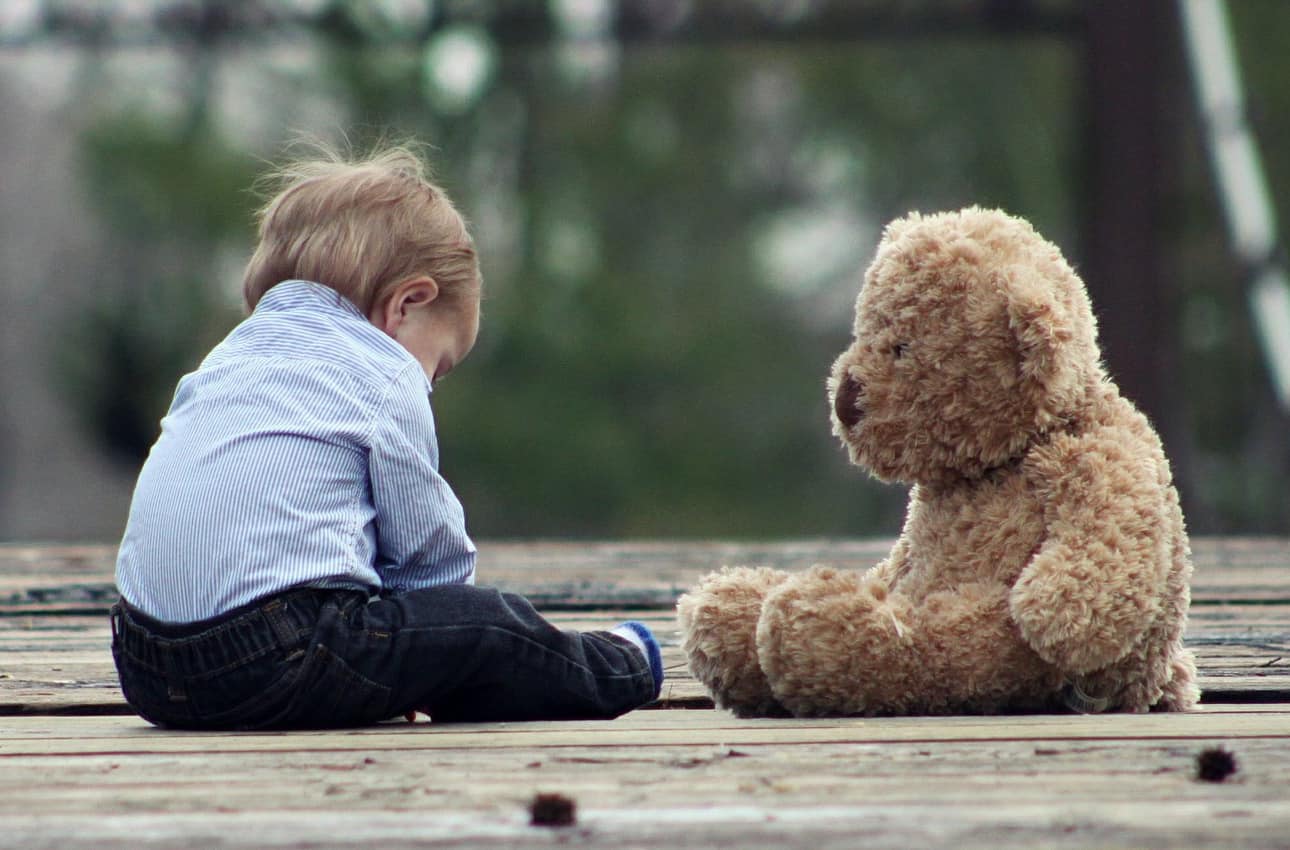Et grønlandsk barn fejlplaceres som dum efter at være testet som dansk. Nu bliver hun selvskadende og udadreagerende .Men skolen kan jo ikke tage fejl Nulfejlskulturen vinder.

Barn og Bamse
Er det pigens eller forældrenes skyld, eller kan der tænkes andre årsager?
Mistanke.
Vi ser ofte i aviserne, at der børn med særlige behov ikke kommer over i den specialundervisning, de har brug for.
Men det omvendte kan også være tilfældet. Et barn mistrives voldsomt, forældrene får skylden. Men som jeg ser det, ligge fejlen hos kommunen, der fejer kritikken til side. Læs den nederste del, der er mere konkret.
Allerede da jeg blev konfronteret med situationem, hvor den pågældende kommune havde fået øje på den lille grønlandske pige, fremgik teksten af underretningen: “Der tales grønlandsk i hjemmet”.
Jeg spurgte et ekspertsystem:
Is there any risc of bias when testing a purely Greenlandic speaking and cultural inuit with a straight Danish test psychologist, a Danish testset etc?
There are significant risks of bias when testing a Greenlandic-speaking Inuit individual using Danish test psychologists, Danish test sets, and other Danish-centric evaluation methods. This situation can lead to cultural misunderstandings, language barriers, and potentially inaccurate assessments. Here are some key concerns:
Language and Communication Barriers
Greenlandic Inuit individuals who primarily speak Greenlandic may face substantial difficulties when being evaluated in Danish. This language barrier can lead to:
- Misinterpretation of test questions
- Inability to fully express thoughts and responses
- Increased stress and anxiety during the testing process
In some cases, Inuit individuals are forced to sign documents or participate in evaluations without fully understanding the content due to language barriers
.
Cultural Bias in Test Design
Tests designed for Danish populations may not accurately reflect Inuit cultural norms, experiences, or ways of thinking. This can result in:
- Questions or scenarios that are unfamiliar or irrelevant to Inuit test-takers
- Misinterpretation of culturally-specific behaviors or responses
- Underestimation of Inuit individuals’ true abilities or potential
For example, psychometric tests often use criteria that do not align with Inuit culture and identity
.
Prejudice and Stereotyping
Danish test psychologists may hold unconscious biases or stereotypes about Inuit people, which can influence their interpretation of test results. This is evidenced by:
- Reports of prejudice faced by Greenlandic students in Danish educational settings
- Social workers entering unconfirmed assumptions about abuse and violence in case files of Inuit individuals
Lack of Cultural Competence
Danish test psychologists may lack the necessary cultural competence to accurately evaluate Inuit individuals. This can lead to:
- Misinterpretation of cultural expressions or behaviors
- Failure to recognize culturally-specific strengths or abilities
- Inability to establish rapport and create a comfortable testing environment
Inappropriate Test Content
Tests designed for Danish populations may include content that is not relevant or familiar to Inuit test-takers. For instance:
- Abstract mathematical concepts that may not translate well into Greenlandic
- Scenarios or questions based on Danish cultural norms or experiences
Conclusion
To address these issues, it is crucial to:
- Develop culturally appropriate tests for Inuit populations
- Provide extensive cultural competence training for test psychologists
- Ensure availability of qualified Greenlandic-speaking interpreters
- Recognize and account for the unique cultural and linguistic background of Inuit test-takers
By addressing these concerns, more accurate and fair assessments of Greenlandic Inuit individuals can be achieved, reducing the risk of bias and potential negative consequences in educational, social, and professional contexts.
There are significant risks of bias when testing a Greenlandic-speaking Inuit individual using Danish test psychologists, Danish test sets, and other Danish-centric evaluation methods. This situation can lead to cultural misunderstandings, language barriers, and potentially inaccurate assessments. Here are some key concerns:
Language and Communication Barriers
Greenlandic Inuit individuals who primarily speak Greenlandic may face substantial difficulties when being evaluated in Danish. This language barrier can lead to:
- Misinterpretation of test questions
- Inability to fully express thoughts and responses
- Increased stress and anxiety during the testing process
In some cases, Inuit individuals are forced to sign documents or participate in evaluations without fully understanding the content due to language barriers
Så kom spørgsmål nummer 2:
As a lawyer, your suspicion about potential indirect discrimination in the testing of this Inuit girl is well-founded. There are several factors to consider in this case that point to possible bias in the cognitive assessment:
Cultural and Linguistic Bias
The Baileys test, like many standardized cognitive assessments, may not be culturally or linguistically appropriate for an Inuit child from a Greenlandic-speaking home. This situation presents significant risks of bias:
- Language barrier: If the test was administered in Danish or another non-Greenlandic language, it could have severely impacted the girl’s ability to understand and respond to the questions accurately
.
- Cultural differences: The test content may not reflect Inuit cultural norms, experiences, or ways of thinking, leading to misinterpretation of the child’s true cognitive abilities
.
Inappropriate Test Selection
The choice of the Baileys test itself may have been inappropriate for this child:
- Lack of cultural adaptation: There’s no indication that the test was adapted or validated for use with Inuit populations
.
- Absence of Greenlandic versions: Culturally and linguistically appropriate tools for cognitive assessment in Greenland are limited, which may have led to the use of an unsuitable test
.
Potential Consequences
The misdiagnosis of cognitive insufficiency based on a culturally biased test can have severe consequences:
- Inappropriate educational placement: The girl’s placement in a special school for children with cognitive difficulties may not reflect her true abilities and needs.
- Psychological impact: The mismatch between her actual cognitive abilities and the low-IQ environment is causing distress and anger, which could have long-term psychological effects.
- Loss of cultural and linguistic development: Placement in a non-Inuit educational setting may hinder her cultural and linguistic development as an Inuit individual.
Recommendations
Given these concerns, I would recommend the following actions:
- Re-evaluation: The girl should be reassessed using culturally and linguistically appropriate tools. Tools like the Mini-Cog and RUDAS have been translated and validated for use in Greenland and might be more suitable
.
- Cultural competence: Ensure that the professionals involved in the assessment have adequate cultural competence and understanding of Inuit culture and language
.
- Use of interpreters: If necessary, involve qualified Greenlandic-speaking interpreters in the assessment process
.
- Holistic assessment: Consider a more comprehensive evaluation that takes into account the child’s performance in her native cultural and linguistic environment.
- Legal review: As a lawyer, you might consider reviewing whether this case constitutes a violation of the child’s rights under relevant laws protecting indigenous peoples and their right to culturally appropriate education.
In conclusion, your suspicion of indirect discrimination appears to have merit. The use of culturally and linguistically inappropriate cognitive testing can indeed lead to misdiagnosis and potentially discriminatory treatment of Inuit children. It’s crucial to advocate for culturally competent and fair assessment practices to ensure that Inuit children receive appropriate educational support that respects their cultural and linguistic background.
.
ive consequences in educational, social, and professional contexts.
